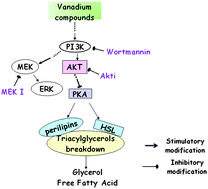The increased plasma free fatty acid levels due to the deregulated lipolysis in adipocytes are considered as one of the major risk factors for developing type II diabetes. Vanadium compounds are well-known for their antidiabetic effects both on glucose and lipid metabolism, but the mechanisms are still not completely understood. The present study suggests a mechanism for how vanadium compounds exert antilipolytic effects. It demonstrates that all the three vanadium compounds, bis(acetylacetonato)-oxovanadium(IV) (VO(acac)2), bis(maltolato)-oxovanadium(IV) (VO(ma)2) and sodium metavanadate (NaVO3), attenuated basal lipolysis in 3T3L1 adipocytes in a dose- (from 100 to 400 μM for VO(acac)2 and VO(ma)2, 1.0 to 4.0 mM for vanadate) and time-dependent (from 0.5 to 4 h) manner using the glycerol release as a marker of lipolysis. In addition, the three compounds inhibited lipolysis to a different extent. Among them, VO(acac)2 (from 100 to 400 μM) exerted the most potent effect and reduced the lipolysis to ∼60–20% of control after 4 h treatment. The antilipolytic effects of vanadium compounds were further evidenced by a decrease of the levels of phosphorylated HSL at Ser660 and phosphorylated perilipin, which were counteracted by inhibitors of PI3K or Akt but not by an MEK inhibitor. This indicates that though both Akt and ERK pathways are activated by the vanadium compounds, only Akt activation contributes to the antilipolytic effect of the vanadium compounds, without the involvement of ERK activation. We previously demonstrated that VO(acac)2 can block cell cycle progression at the G1/S phase via a highly activated ERK signal in human hepatoma HepG2 cells. Together with this study, we show that similar activated pathways may lead to differential biological consequences for cancer cells and adipocytes, indicating that vanadium compounds may be used in the prevention and treatment of both diabetes and cancer.

You have access to this article
 Please wait while we load your content...
Something went wrong. Try again?
Please wait while we load your content...
Something went wrong. Try again?


 Please wait while we load your content...
Please wait while we load your content...